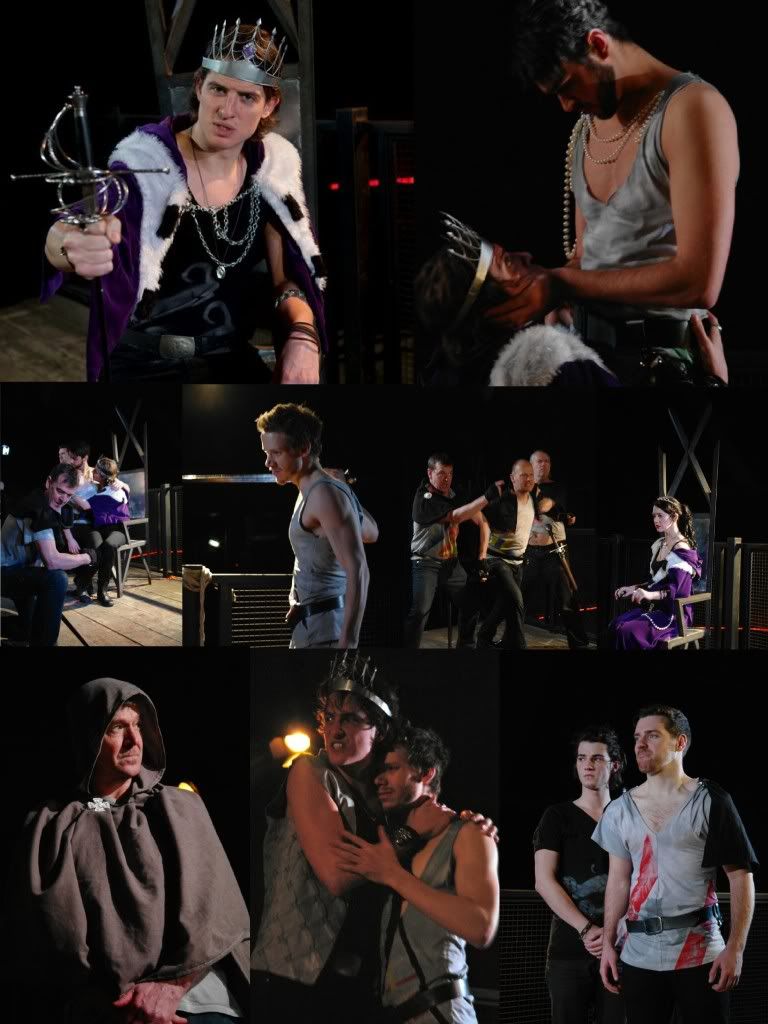Oh… I really loved this one, despite it being frequently, utterly ridiculous – I came out glowing and wanting to babble continuously about it and the only thing that stopped me from buying another ticket for it was the utter lack of time I had to fit another performance in.
This was the first Marlowe I’d seen and I was blown away by how dark and beautiful the play and language are. I immediately went home and cracked open my copy of the play and just revelled it and now I have this image (almost certainly incorrect) of Marlowe and Shakespeare as some sort of Lennon and McCartney of their age, spurring each other to greater achievements. At any rate, I’m looking forward to much more Marlowe in my future. I mean how could I resist with speeches like this:
"A litter hast thou? Lay me in a hearse,
And to the gates of hell convey me hence;
Let Pluto's bells ring out my fatal knell,
And hags howl for my death at Charon's shore..."
Similarly it was also my first, though certainly not my last, time visiting the Rose Bankside. As theatres go, it’s about as basic as it comes – for various reasons they can’t have toilets or heating (if you go, dress up warm as it was absolutely freezing and you end up wincing for the more scantily clad actors). The stage is just a small platform surrounded by chairs and both the lighting and the sound equipment is basic. But for all that it’s stunning. It’s crushed beneath an office building, the ceiling low and claustrophobic with the cavernous remains of the dig stretching behind the stage, just visible beneath the water like the mouth of hell. The acoustics are amazing and the whole thing feels dark and ominous. It’s not the sort of place you’d see As You Like It perhaps, but for Edward II it was superb.
Plus it was exactly what I want archaeological sites to be. I studied archaeology at university and was fascinated by it but simultaneously came away oddly repulsed. There is a huge range of approaches to archaeology but there was something territorial and hidden about many digs that left me unsettled and in the end archaeology is utterly destructive. Here that destructiveness is being balanced by creativity and even better it is open and accessible, plus the sense of salvation and preservation is palpable. It made my heart sing and I’ve now decided firmly on seeing Henry IV part 1 there this summer and am eyeing up Anthony and Cleopatra greedily.
On top of this new love for Marlowe and the Rose, it was somewhat stunning to come across a queer narrative from the past. LGBT representation has been somewhat erased in our history, mythology and stories in ways that aren’t true of other cultures – so finding the ones that survived is very special for me. This production as well has chosen to highlight that element, alongside the copious amounts of physical affection between various main characters, there have also been a number of cuts to the text which serve to strengthen and simplify the relationship between Edward and Gaveston into a love story. This is mostly done at the expense of Gaveston’s character, who loses his complexity and most of his more Machiavellian moments (perhaps it’s just that I’ve been seeing lots of Lear’s recently but Gaveston has definitely struck me as an Early-Edmund). Though in some ways these losses are balanced out by the cuts adding an epic doomed feel to the central love story.
The production elements here were something of a mixed bag – they had little in the way of set, though they made excellent use of the striking throne shown above throughout (the image of Edward huddled on the arm of the throne is one that has stuck with me). The lighting was similarly simply but effectively used – moments where characters were silhouetted from behind or the whole hellish pit of the pool was bathed in red light adding contrast and drama. The sound was more mixed, it was used mostly to delineate scenes and whilst some sections worked well, I wasn’t sure that the edgier more disco beats of some really did anything for me, though they didn’t overly detract either. The costumes were more difficult – as though it was necessary to alter costumes to distinguish the various roles the actors were playing, it was here that it was clearest how little budget the production had had to play with and some of the attempts were just short of farcical. Plus the use of low cut tops and strings of pearls and dresses cut high enough to show stocking tops made characters seem rather sillier than they really ought to have.
Eventually though, it was easy to ignore all that as what made this production really great was the performances. The cast were routinely strong and there were several truly standout performances that have convinced me I will be seeing these actors in grander surroundings soon. Not least of which was Matthew Barber’s excellently conflicted performance as Edward. From start to finish, the actors gripped my attention and made me care passionately about what all the characters were experiencing. Partly this was the dedication with which they approached each emotional element and there are some moments that have really stuck with me – like the look in Gaveston’s eyes when he asked if he would see the king again or the way Edward took Gaveston’s sword after learning of his death.
The production was swift and committed and violent and despite the cold discomfort of the theatre (which rather added to your sympathy for Edward) – the production flew by without remorse until at the end I felt truly shaken. Which is exactly what I want from the theatre.

No comments:
Post a Comment